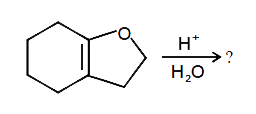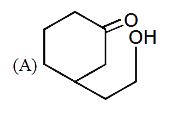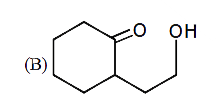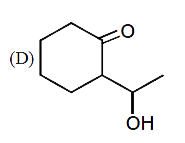With the help of F.C. Explain which Lewis structure is more stable for the following molecules :
(a) N2O:(i):Θ..N=2+O=..N:Θor(ii):N≡⊕N−..O..:Θ
(b). H2SO4:(i)H−O−:..O:Θ∣S+2∣:O..:Θ−O−Hor(ii)H−O−..O:∣∣S∣∣:..O−O−H
HNO3(i)H−O−⊕N∣:O..:Θ=..O:or(ii)H−O−+2N∣:..O:Θ−..O..:Θ
(d). CI2O:(i):....CI−..O..−..C..I:or(ii):..O..−..CI..−..C..I:
Video Solution
Text Solution
(a) Structure (ii) is more stable, as it has less F.C. The central N has an F.C of +1 and O has an F.C of −1 But in structure (i), both N atoms have F.C of −1 and O has F.C of +2.
(b) Structure (ii) is more stable, as it has no F.C, whereas structure (i) has F.C of +2 on S and F.C of −1 on each O.
S has d orbitals, so it can expand its octet to have more than eight ¯e,s.
( c) Structure (i) is more stable, as it has less F.C. than structure (ii). Moreover, structure (ii) is not possible, because N has no d orbitals, so it cannot expand its octet and is limited to an octet.
(d) Structure (i) is more stable, as it has no F.C., whereas structure (ii) has F.C. of −1 on O and of +1 on central C1.
F.C, in (i) : F.C on each C1=[7−6−12(2)]=0
F.ConO=[6−4−12(4)]=0
F.C in (ii) F.C on O=[6−6−12(2)]=−1
F.C on central C1=[7−4−12(4)]=+1
F.C on terminal C1=[7−6−12(2)]=0.
|
Topper's Solved these Questions
- GENERAL ORGANIC CHEMISTRYBOOK - CENGAGE CHEMISTRYCHAPTER - GENERAL ORGANIC CHEMISTRYEXERCISE - Solved Example
18 Videos
- GENERAL ORGANIC CHEMISTRYBOOK - CENGAGE CHEMISTRYCHAPTER - GENERAL ORGANIC CHEMISTRYEXERCISE - Subjective
11 Videos
- CLASSIFICATION AND NOMENCLATURE OF ORGANIC COMPOUNDSBOOK - CENGAGE CHEMISTRYCHAPTER - CLASSIFICATION AND NOMENCLATURE OF ORGANIC COMPOUNDSEXERCISE - Analytical and Descriptive Type
3 Videos
- HYDROGEN, WATER AND HYDROGEN PEROXIDEBOOK - CENGAGE CHEMISTRYCHAPTER - HYDROGEN, WATER AND HYDROGEN PEROXIDEEXERCISE - Subjective Archive (Subjective)
3 Videos
Similar Questions
Knowledge Check
Θ..CH2−C∣∣O−CH3andCH2=C∣:O..:Θ−CH3 are :
AResonating structuresBTautomersCGeometrical isomersDOptical isomersH−H∣C∣H−O∣∣C−O−H∣C∣H−H is a/ an _____.
ACarboxylic acidBketoneCaldehydeDester
H+−−→H2O ?A B
B C
C D
D
Write the names of the following compounds :
H−H∣C∣H−H∣C∣H−H∣C∣H−H∣C∣H−O∣∣C−H
View SolutionWrite the names of the following compounds :
H−H∣C∣H−H∣C∣H−H∣C∣H−H∣C∣H−O∣∣C−OH
View SolutionWrite the names of the following compounds.
(a)H−H∣C∣H−H∣C∣H−H∣C∣H−H∣C∣H−O∣∣C−OH (b)H−H∣C∣H−H∣C∣H−C≡C−H
View SolutionWrite the IUPAC names of the following compounds :
H−H∣C∣H−H∣C∣H−H∣C∣H−H∣C∣H−H∣C∣H−H∣C∣H−−H∣C=O
View SolutionWrite the IUPAC names of the following compounds :
H−H∣C∣H−H∣C∣H−H∣C∣H−H∣C∣H−H∣C∣H−H∣C∣H−−H∣C=O
View Solution
